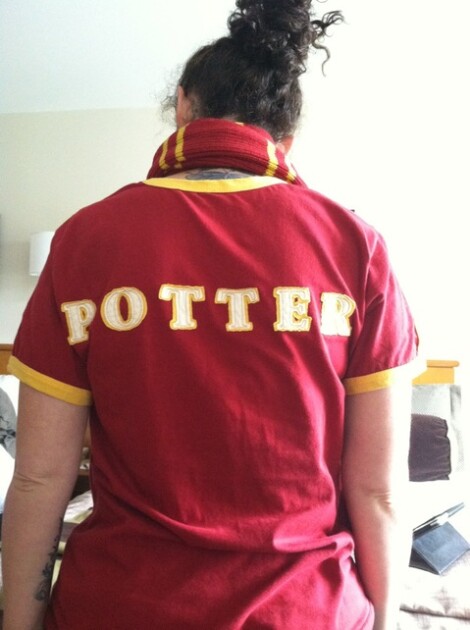Harry Potter: Lessons Learned From Past Adaptations

Table of Contents
The Success of the Film Series
The Harry Potter movie franchise, running from 2001 to 2011, remains a monumental achievement in adapting a beloved book series. However, even this hugely successful undertaking faced challenges in balancing fidelity to the source material with the demands of cinematic storytelling.
Balancing Fidelity and Adaptation
The films achieved a remarkable balance, generally capturing the essence of the books.
- Successful Adaptations: The portrayal of Hogwarts, the development of the central trio's friendship, and the climactic battles at the Ministry of Magic and Hogwarts were largely successful in translating the emotional core of the books to the screen. Key scenes like the Quidditch matches and the Yule Ball were visually stunning and impactful.
- Failures in Adaptation: However, significant plot points and character subplots were inevitably omitted or simplified to fit the runtime. The complexities of certain characters, like Snape, were arguably somewhat flattened, and some crucial emotional beats were lost in the transition. The pacing also often differed greatly from the books.
This demonstrates the inherent challenge in book to film adaptation: a delicate dance between satisfying dedicated fans and crafting a compelling story for a wider audience. The Harry Potter movies largely succeeded in this, creating a cinematic universe that resonated with millions.
Casting and Performance
The casting of the main trio—Daniel Radcliffe as Harry, Emma Watson as Hermione, and Rupert Grint as Ron—proved pivotal to the franchise's success. Their performances evolved convincingly alongside their characters, fostering a deep connection with the audience.
- Successful Castings: The choice of actors was arguably perfect, with the trio’s chemistry and performance genuinely capturing the spirit of the books. Supporting actors, like Alan Rickman as Snape and Maggie Smith as McGonagall, provided equally compelling portrayals.
- Less Successful Castings: While mostly praised, some casting decisions, particularly in later films, received mixed reviews, highlighting the importance of meticulous actor selection for long-running franchises.
This success highlights the power of character portrayal and the importance of selecting actors capable of embodying the spirit of beloved literary characters.
Visual Effects and Production Design
The Harry Potter films excelled in bringing the magical world to life.
- Successful Visuals: The visual effects, though showing their age in some cases, were groundbreaking for their time, and the detailed set design of Hogwarts and other locations immersed viewers in the wizarding world. The creation of magical creatures and spells was generally impressive.
- Areas for Improvement: Some critics argued that certain magical effects lacked finesse in the earlier films, but overall, the visual aspects significantly contributed to the series’ widespread appeal. The blend of practical effects and CGI proved effective in generating a sense of wonder.
The dedication to detailed set design, believable special effects, and immersive locations proved crucial to the success of the Harry Potter film series.
Analyzing Other Adaptations (Games and Stage Play)
Beyond the films, the Harry Potter franchise has ventured into other mediums, with varying degrees of success.
Video Game Adaptations
The Harry Potter games present a unique challenge: translating the immersive reading experience into an interactive format.
- Successful Games: Some games, especially those released closer to the film releases, successfully captured the charm and atmosphere of the wizarding world through engaging gameplay.
- Unsuccessful Games: Others failed to capture the magic, often falling short in terms of story adherence, gameplay mechanics, or overall quality. These highlighted the difficulty of translating a rich narrative into a compelling interactive experience. A consistent struggle was balancing gameplay with staying true to the source material.
The success of Harry Potter games depended heavily on the developer's ability to balance faithfulness to the source material with innovative gameplay.
Harry Potter and the Cursed Child
The stage play, Harry Potter and the Cursed Child, tackled a different set of challenges.
- Strengths of the Play: The play cleverly used stagecraft to create the magical world and received praise for its inventive storytelling and its exploration of familiar characters’ post-Hogwarts lives.
- Weaknesses of the Play: However, its departure from established canon divided fans, and its complex plot, while ambitious, proved difficult for some viewers to follow. The adaptation also showcased the inherent differences between theatrical adaptation and the original novels.
Harry Potter and the Cursed Child demonstrates the complexities of adapting established narratives for a completely different medium, requiring careful consideration of audience expectations and narrative constraints of the chosen format.
Lessons Learned for Future Adaptations
The varied experiences of past Harry Potter adaptations offer valuable lessons for future projects.
Prioritizing Source Material
Respect for the source material is paramount. However, rigid adherence can stifle creativity.
- Strategies for Balancing Fidelity and Creative License: Future adaptations should aim for a nuanced approach, respecting core elements while employing creative freedom to enhance the story for the new medium. This might involve expanding upon existing subplots or creating new storylines that resonate with the spirit of the original work. The key is to find that sweet spot between faithfulness and creative freedom.
Targeting the Audience
Different adaptations need to appeal to different demographics.
- Appealing to Different Demographics: A film adaptation might target a broader audience than a video game aimed at a specific age group. Understanding the target fan base and crafting content accordingly is critical. Effective marketing to these specific demographics is also key to success.
Understanding and tailoring content for the intended target audience is essential for the success of any adaptation.
Innovation and New Approaches
Future Harry Potter adaptations should explore new media and storytelling techniques.
- Exploring Emerging Technologies: The potential of virtual reality and augmented reality to immerse fans in the wizarding world offers exciting possibilities. Interactive narratives and personalized experiences could engage audiences in new ways.
Embracing technological innovation can lead to fresh and captivating future adaptations of the Harry Potter universe.
Conclusion
The history of Harry Potter adaptations shows that success hinges on a carefully balanced approach. While fidelity to the source material is essential, creative adaptation is equally crucial to engaging new audiences and bringing the magic of the wizarding world to life in fresh and exciting ways. The most successful Harry Potter adaptations understood the importance of crafting compelling narratives for their chosen mediums, while still honoring the spirit and essence of J.K. Rowling’s original work. What are your thoughts on the most successful and unsuccessful Harry Potter adaptations? Let us know, and let’s look forward to the future of Harry Potter adaptations!

Featured Posts
-
 Activision Blizzard Acquisition Ftcs Appeal And The Future Of Gaming
May 29, 2025
Activision Blizzard Acquisition Ftcs Appeal And The Future Of Gaming
May 29, 2025 -
 Unsolved Homicide In Seattles First Hill Police Appeal To Public For Information
May 29, 2025
Unsolved Homicide In Seattles First Hill Police Appeal To Public For Information
May 29, 2025 -
 Bath And West Show Half Term Show Packs Rides And Animal Encounters
May 29, 2025
Bath And West Show Half Term Show Packs Rides And Animal Encounters
May 29, 2025 -
 The X Files To Breaking Bad How One Role Shaped A Legend
May 29, 2025
The X Files To Breaking Bad How One Role Shaped A Legend
May 29, 2025 -
 Update Marini Hospitalized Following Vehicle Testing Crash
May 29, 2025
Update Marini Hospitalized Following Vehicle Testing Crash
May 29, 2025
